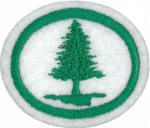Especialidades JA/Árboles/Respuestas
| Árboles | ||
|---|---|---|
| Asociación General
|
Destreza: 2 Año de introducción: 1928 |
|
Requisitos
1
Los árboles son generalmente más altos que los arbustos y tienen un tronco principal de la cual crecen todas las ramas secundarias. Los arbustos son generalmente más cortos y pueden tener múltiples tallos en lugar de un solo tronco. Algunas plantas pueden ser consideradas como arbustos o árboles dependiendo de sus condiciones de crecimiento, por eso la división no deben considerarse exacta.
2
3
3a
- Sweet Gum: the gummy sap of this tree has been used as chewing gum.
- Cork Oak forms a thick, rugged and corky bark. Over time this bark can develop considerable thickness, and this is harvested every 10-12 years as cork.
- Balsam Fir: produces a resin which is known as Canadian Balsam. A balsam is the same thing as a balm, a soothing liquid - anything that soothes, heals, or restores.
- Boxwood: produces a tight-grained wood ideal for carving or for making boxes.
3b
- Mountain Ash grow in the mountainous areas of the northern US and Canada.
- Swamp Ash live in the swamps of the southern US.
3c
- Sugar Maple: The primary source of sugary maple syrup.
- Hornbeam: The common English name of "hornbeam" derives from the hardness of the wood (likened to horn) and the Old English beam, meaning a tree (like the German word "baum" which we know as "tannenbaum").
- Tulip Tree: is so named because its flowers resemble tulip flowers.
3d
- Brazilwood: is not named after Brazil - Brazil is actually named for the tree!
- Cedar of Lebanon, is a coniferous tree native to the mountains of the Mediterranean region, in Lebanon, western Syria and south central Turkey
- Mexican Buckeye is a shrub or small tree native to northeastern Mexico and adjacent western Texas and southern New Mexico.
3e
- Douglas Fir: The common name honors David Douglas, the Scottish botanist who first introduced the tree into cultivation in 1826.
- Fraser Fir: named after John Fraser, a Scottish botanist. Fraser Firs are farmed and sold as Christmas trees.
4
Las dos clases grandes de árboles son gimnospermas y angiospermas. Las gimnospermas no producen flores, sino más bien producen semillas desnudas generalmente unidas a la escala de un cono (como un cono de pino). Las angiospermas sí producen flores que a su vez se convierten en frutas con semillas (o nueces). Más comúnmente, las gimnospermas son llamadas árboles de hoja perenne, aunque esto no es un término exacto, porque algunas angiospermas son perennes (como las palmas y el roble). Además, el Ginkgo es una gimnosperma, pero no es siempre verde. Las gimnospermas y angiospermas también se conocen comúnmente como madeas blandas y duras, aunque esos términos tampoco son muy precisos, como varias gimnospermas tienen madera dura y varias angiospermas tienen madera blanda.
5
Manejado adecuadamente, los bosques son un recurso renovable. Con el fin de garantizar un suministro continuo de productos forestales (como la madera), los bosques deben estar debidamente cortados y replantados. Los bosques también sirven como un hábitat importante para varias especies, tanto animales como plantas. Cuando las plantas pierden su hábitat, simplemente mueren. Cuando los animales pierden su hábitat, algunos morirán y otros pasarán a otras áreas - en particular, las zonas donde viven los seres humanos. Esto promueve encuentros indeseables entre animales potencialmente peligrosos y los seres humanos, con el animal siempre perdiendo.
6
6a
Oak, maple, pine, teak.
6b
Pine, fir, spruce
6c
Walnut, oak, cherry, maple, pine, mahogany
6d
Hickory, ash
6e
Locust, cedar, redwood, fir (treated)
6f
Hardwoods and softwoods.
6g
Oak, hickory, ash
6h
Osage orange, yew, and elm for bows. Cedar, spruce, and fir for arrows
6i
Softwoods such as pine and cedar.
6j
Hardwoods, especially hickory and mesquite.
7
7a
Bald Cypress, Sycamore, Willow, Swamp White Oak, Swamp Chestnut Oak, Overcup Oak, Tupelo Gum and Cottonwood.
7b
Larch, Bristlecone Pine (and many other pines), Birch, and Beech.
Referencias
- Categoría: Tiene imagen de insignia
- Adventist Youth Honors Answer Book/Honors/es
- Adventist Youth Honors Answer Book/es
- Adventist Youth Honors Answer Book/Skill Level 2/es
- Categoría: Libro de respuestas de especialidades JA/Especialidades introducidas en 1928
- Adventist Youth Honors Answer Book/General Conference/es
- Adventist Youth Honors Answer Book/Nature/es
- Adventist Youth Honors Answer Book/Nature/Primary/es
- Adventist Youth Honors Answer Book/Stage 0/es

